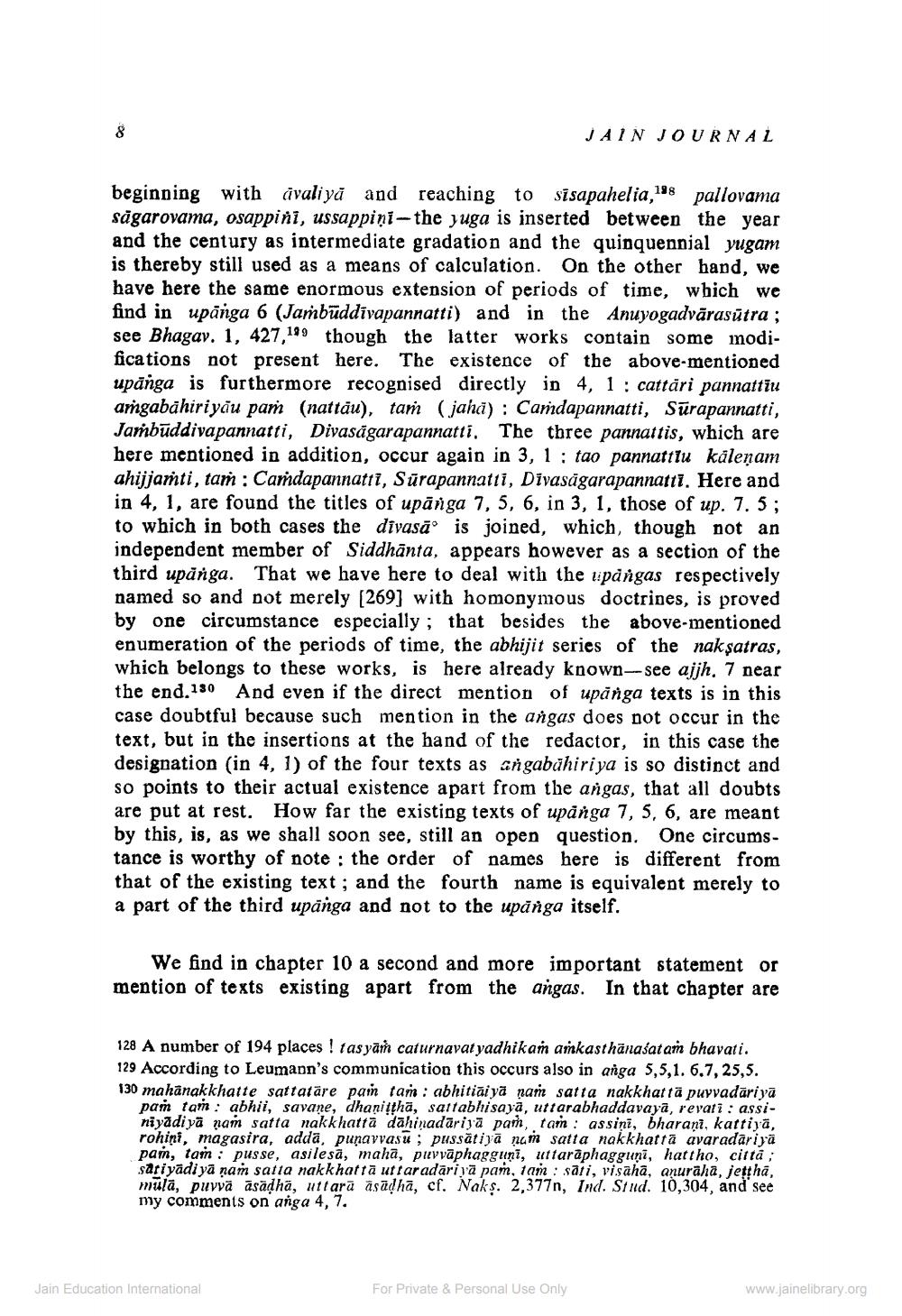________________
8
beginning with avaliya and reaching to sisapahelia,198 pallovama sågarovama, osappini, ussappini-the juga is inserted between the year and the century as intermediate gradation and the quinquennial yugam is thereby still used as a means of calculation. On the other hand, we have here the same enormous extension of periods of time, which we find in upanga 6 (Jambuddivapannatti) and in the Anuyogadvārasūtra ; see Bhagav. 1, 427,199 though the latter works contain some modifications not present here. The existence of the above-mentioned upanga is furthermore recognised directly in 4, 1: cattäri pannattiu amgabahiriyău paṁ (nattau), taṁ (jaha): Camdapannatti, Surapannatti, Jambuddivapannatti, Divasagarapannatti. The three pannattis, which are here mentioned in addition, occur again in 3, 1: tao pannattlu kaleṇam ahijjamti, tam: Camdapannatti, Surapannatti, Divasagarapannatti. Here and in 4, 1, are found the titles of upanga 7, 5, 6, in 3, 1, those of up. 7. 5; to which in both cases the divasa is joined, which, though not an independent member of Siddhanta, appears however as a section of the third upanga. That we have here to deal with the updйgas respectively named so and not merely [269] with homonymous doctrines, is proved by one circumstance especially; that besides the above-mentioned enumeration of the periods of time, the abhijit series of the nakṣatras, which belongs to these works, is here already known-see ajjh. 7 near the end.130 And even if the direct mention of upanga texts is in this case doubtful because such mention in the angas does not occur in the text, but in the insertions at the hand of the redactor, in this case the designation (in 4, 1) of the four texts as angabahiriya is so distinct and so points to their actual existence apart from the angas, that all doubts are put at rest. How far the existing texts of upanga 7, 5, 6, are meant by this, is, as we shall soon see, still an open question. One circumstance is worthy of note: the order of names here is different from that of the existing text; and the fourth name is equivalent merely to a part of the third upanga and not to the upanga itself.
JAIN JOURNAL
We find in chapter 10 a second and more important statement or mention of texts existing apart from the angas. In that chapter are
128 A number of 194 places! tasyam caturnavatyadhikam amkasthānaśatam bhavati. 129 According to Leumann's communication this occurs also in anga 5,5,1. 6.7, 25,5. 130 mahanakkhatte sattatare pam tam: abhitiaiya nam satta nakkhatta puvvadariya pam tam: abhii, savane, dhaniṭṭhā, sattabhisaya, uttarabhaddavaya, revati: assiniyadiya nam satta nakkhatta dahinadariya pam, tam: assini, bharani, kattiya, rohini, magasira, addā, punavvasu; pussatiya nam satta nakkhatta avaradariya pam, tam: pusse, asilesa, mahā, puvvaphagguni, uttaraphagguni, hattho, città; sariyadiya nam satta nakkhatta uttaradariya pam, tam: sati, visaha, anuraha, jetṭhā, mula, puvva asaḍha, uttara asudha, cf. Naks. 2,377n, Ind. Stud. 10,304, and see my comments on anga 4, 7.
Jain Education International
For Private & Personal Use Only
www.jainelibrary.org




